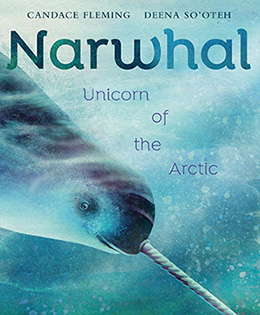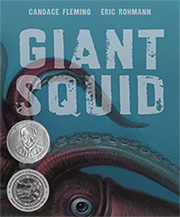BOOKS

illustrated by Deena So’Oteh
Anne Schwartz Books /
Penguin Random House,
October 22, 2024
978–0593377789
ages 6 and up
buy the book
hardcover
e‑book
audio book
After you’ve read Narwhal: Unicorn of the Arctic, try this book:
Narwhal
Unicorn of the Arcitc
You are a narwhal.
Shy… Swift… Small…
Humans call you unicorn of the Arctic.
When winter ice covers the Arctic Ocean, a narwhal pokes his head through a patch of open water, his tusk — a six-foot long tooth — pointed to the sky.
Join this mammal as he jousts with another narwhal, floats with his pod, and uses echolocation to find his prey. When warmer weather arrives, he will migrate towards summer ground. But he must be careful! Predators — orcas and polar bears — will be hungry and looking for a meal…. How will the narwhal escape? Will he be able to return to the winter bay?
Paired with atmospheric illustrations by debut illustrator Deena So’Oteh, nonfiction master Candace Fleming delivers a picture book, uniquely told in second person, that expertly explores the mysterious and fascinating unicorn of the Arctic.
Awards and Honors
- Bank Street College of Education Best Children’s Books 2025
- Booklist Editor’s Choice
- The Horn Book Best Book
Resources
- “ ‘Heck, yeah, collapsible ribs!’ A talk with Candace Fleming about Her Incredible New Title, Narwhal: Unicorn of the Arctic,” Betsy Bird, School Library Journal, 26 Sept 2024
Reviews
“You are a narwhal,” Fleming writes, “shy, / swift, / small (for a whale).” With one giant tooth that is “taller than a man,” not to mention “green with algae,” “alive with sea lice,” and still, researchers say, of uncertain function, the sleek, mottled form in So’Oteh’s glowing, light-drenched marine settings floats sociably with other members of its pod. “Side by side by side,” the whales peek out through a gap in the ice until hunger leads to a rolling dive into darker regions for food. Lengthening days signal that it’s time to move to summer waters, avoiding predatory orcas; at summer’s end, the annual migration continues, despite the spread of ice across the water and roving polar bears that make access to the air hazardous. Simultaneously immersive, lyrical, and informative, Fleming’s text shines, accompanied by So’Oteh’s luminous art. Narwhals may not (yet) be endangered, the author concludes, even if their Arctic habitat is definitely threatened by climate change. The species may be of “least concern” to the International Union for Conservation of Nature, but in the wake of this sympathetic portrait and its substantially factual afterword, readers will find these real-life unicorns of “most interest.” Rich in facts and feelings, a warm invitation to join the pod of sea mammal lovers. (Kirkus Reviews, starred review)
“In prose both graceful and suspenseful, Fleming (Mine!) introduces the “shy,/ swift/ small (for a whale)” narwhal, weaving scientific observation into gripping storytelling. Icy landscapes and naturalistic, watery blue aquatic scenes of whales and other marine life by So’oteh, making her picture book debut, add to the drama. Opening with a description of the mammal’s most distinctive feature — “a single/ twisting/ rod of ivory/ that sprouts from your upper left jaw” — lines describe the way male narwhals use their tusks for combat. Subsequent pages trace the rhythms of narwhal life, first in the winter as they dive for fish and surface to breathe, and next as summer migration to warmer southern seas draws hundreds, somewith newborn calves. Returning north, a sudden freeze threatens the pod, whose members cannot breathe beneath the ice. And when they create a small hole to surface, they’re exposed to predators (“You are discovered!”), a moment captured from the narwhal’s underwater view as a polar bear puts an enormous paw into the breathing hole. Together, art and text make this species biography not merely a lesson but an adventure, too. (Publishers Weekly, starred review)
“This will be popular with animal lovers everywhere—particularly those convinced these unicorns are imaginary.” (Booklist, starred review)
“The digital art embodies an approach of wonder and science ….This would make an informative class read, or as a nonfiction companion to the sillier Narwhal of the Narwhal and Jelly series.” (The Bulletin of the Center for Children’s Books)


